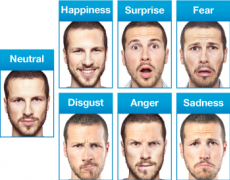
Perhaps the most well-known type of non-verbal communication is facial expressions, and these are generally used to express emotion. Facial expressions have been studied back since the days of Charles Darwin, when he suggested that there must be a small finite number of emotions, each of which could be displayed with a facial expression. About 150 years later, we now believe there to be 6 basic emotions: Anger, Happiness, Surprise, Fear, Sadness and Disgust. Each basic facial expression has a unique pattern of muscle movement that is quite consistent from use to use, though there may be some minor changes in the extent to which the pattern is displayed on different occasions. There are now programs that have been designed which can recreate the basic emotions on a computer model to the point that they can be recognised by real people, showing the consistency in the movements between different people and different events. However when and how often these key emotions are displayed is not necessarily the same for all people, and current research has focused more on the differences between people in their use of facial expressions.
In most cultures, women report experiencing greater levels of emotions that represent powerlessness, such as fear and sadness, while men report higher levels of powerful emotions, such as anger. Across cultures, the use of facial expressions also seems to be fairly consistent. The well-known researcher Ekman showed people from a large variety of different cultures, including tribal cultures, pictures of people using the expressions and found that people could generally recognise the emotions shown and what they represented. This points to an evolutionary and natural explanation for the expressions since it is most likely that all people have developed in the same way because it is in our biology to do so.
Some have criticised Ekman’s work, claiming that since the photos that were used contained actors ‘putting on’ the emotions, they were not very realistic or life-like and so can tell us nothing about real world emotion recognition. However, the experiments have since been redone using emotions shown in both Japanese and American soap-operas and the results still appear to be very positively in favour of the belief that it is an innate human ability. Further support for this is that those who are born blind, deaf and without hands appear to still be able to reciprocate the emotions at appropriate times and they have not had any of the normal socialisation that the rest of the world will have been subject to.
Though there are still some critics, in general, this is the accepted idea about facial expressions today, and Ekman has continued to work on this theory. He is now trying to understand exactly how far back in our evolutionary past the use of the six basic emotions goes by comparing human facial expressions with those of chimpanzees and other apes. This will enable researchers to see how much of our emotional use is uniquely human.
Though this research provides strong support for the idea that emotions are an innate ability, it cannot account for the fact that there are still some differences cross-culturally and between individuals in their use of emotions, and in another article, I’ll be discussing how Ekman explains this problem.
Image from: http://www.omron.com/ecb/common/img/product/mobile/okao07/okao07-img01.jpg

0 Comment:
Be the first one to comment on this article.